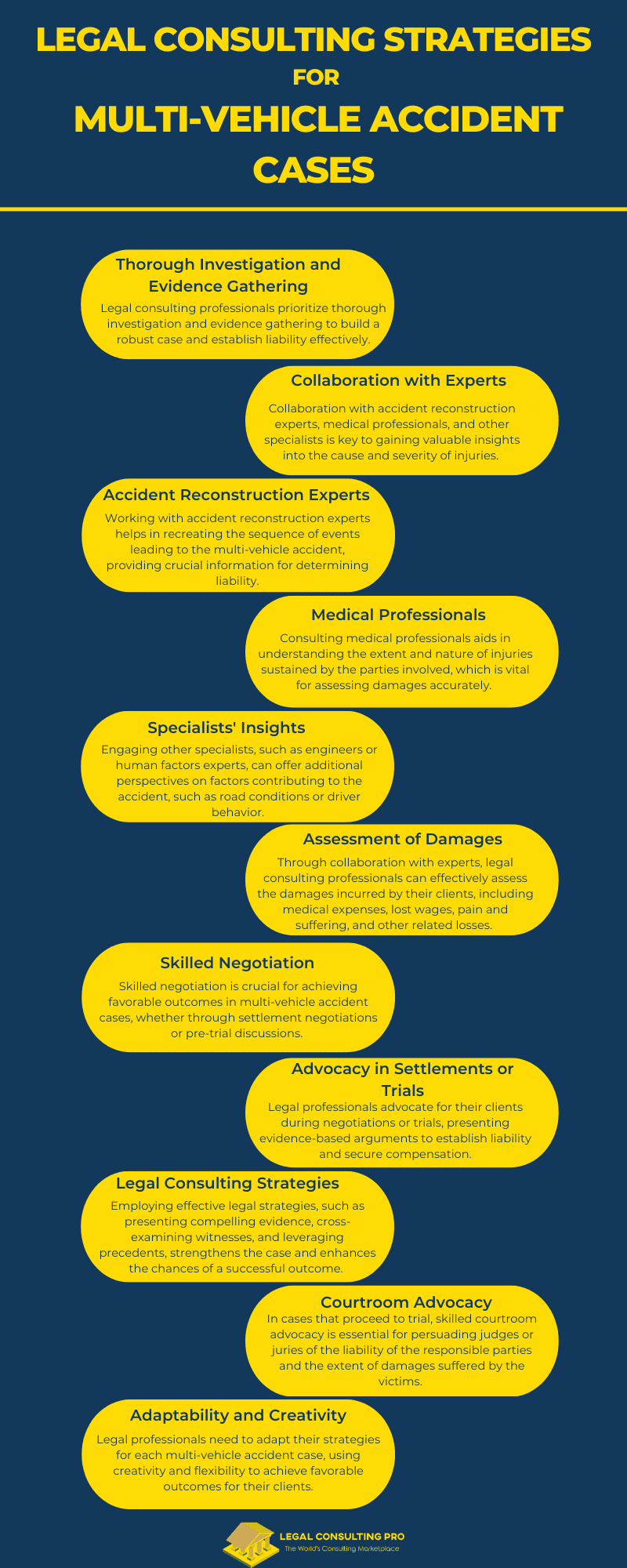Multi-vehicle personal injury accidents, colloquially termed pile-ups or chain-reaction collisions, are notorious for their complexity and the multitude of legal consulting challenges they pose. These personal injury accidents, characterized by the involvement of multiple vehicles, often result in severe injuries, substantial property damage, and intricate liability disputes. Given the gravity of the consequences, it is imperative for all stakeholders, including victims, insurance companies, and legal professionals, to comprehend the intricate legal consulting dynamics inherent in multi-vehicle accidents.
The purpose of this article is to delve into the complexities surrounding liability issues in multi-vehicle personal injury accidents and offer valuable legal insights aimed at equipping individuals with the knowledge necessary to effectively navigate these intricate scenarios. By shedding light on the intricacies of liability determination, this article aims to empower readers to better understand their rights, obligations, and legal consulting options in the aftermath of a multi-vehicle accident.
Through a comprehensive examination of the legal consulting principles, challenges, and strategies pertinent to multi-vehicle accidents, this article seeks to provide actionable guidance for all parties involved in these complex situations.
The Complexity of Multi-Vehicle Personal Injury Accidents
Multi-vehicle accidents, colloquially known as pile-ups, present a complex and often chaotic scenario on highways, freeways, or busy urban roads. These incidents, involving three or more vehicles, are particularly prevalent in areas characterized by high speeds and dense traffic, where the conditions are ripe for chain-reaction collisions to occur.
Several factors can contribute to the initiation and escalation of multi-vehicle personal injury accidents:
- Distracted Driving: With the prevalence of smartphones and other electronic devices, distracted driving has become a leading cause of personal injury accidents. Even a momentary lapse in attention can result in a collision, setting off a chain reaction as other vehicles respond.
- Adverse Weather Conditions: Rain, snow, fog, or ice can significantly impair visibility and reduce traction, increasing the likelihood of personal injury accidents. Reduced stopping distances and decreased control over vehicles can lead to a cascade of collisions when one vehicle loses control.
- Mechanical Failures: Malfunctioning brakes, tire blowouts, or engine failures can cause a vehicle to suddenly slow down, veer off course, or stop abruptly, catching following vehicles off guard and triggering collisions.
- Sudden Changes in Traffic Flow: Traffic congestion, construction zones, or sudden lane closures can force vehicles to slow down or change lanes rapidly, increasing the risk of rear-end collisions or sideswipes as drivers react to the changing conditions.
Due to the rapid sequence of events and the involvement of multiple vehicles, determining liability in multi-vehicle personal injury accidents can be exceptionally challenging. Factors such as the speed of each vehicle, their following distances, driver reactions, road conditions, and any contributing factors like intoxication or fatigue must all be carefully considered.
Investigating authorities may rely on various pieces of evidence to reconstruct the events leading up to the accident, including eyewitness testimonies, traffic camera footage, vehicle telemetry data, and physical evidence from the scene. However, even with these resources, assigning fault accurately can be a complex and contentious process.
Insurance companies, legal representatives, and law enforcement agencies often work collaboratively to piece together the sequence of events and apportion liability based on the available evidence. In some cases, multiple parties may share responsibility for the accident, leading to complex negotiations and legal proceedings to determine each party’s degree of fault and the resulting financial liabilities.
Ultimately, preventing multi-vehicle personal injury accidents requires a combination of driver vigilance, adherence to traffic laws, regular vehicle maintenance, and infrastructure improvements to mitigate the impact of adverse conditions and reduce the likelihood of chain-reaction collisions.
Legal Principles Governing Multi-Vehicle Accidents
In cases of multi-vehicle personal injury accidents, determining liability hinges on principles of negligence and causation. Each driver involved in such an incident is expected to uphold a duty of care while operating their vehicle. When this duty is breached and leads to an accident, the negligent driver may be held responsible for resulting damages. However, in multi-vehicle accidents, liability is often a complex issue, as it frequently involves shared responsibility among multiple parties. Understanding each driver’s degree of fault becomes paramount in these situations, requiring a careful examination of the accident’s circumstances. Below, we elaborate on the key points involved in determining liability in multi-vehicle accident cases.
Principles of Negligence and Causation:
- Liability in multi-vehicle accident cases is typically determined based on principles of negligence and causation.
- Negligence refers to the failure of a driver to exercise reasonable care while operating their vehicle.
- Causation establishes a direct link between the negligent actions of a driver and the resulting accident.
Duty of Reasonable Care:
- Each driver involved in the accident has a legal duty to exercise reasonable care while driving.
- This duty includes obeying traffic laws, maintaining proper control of the vehicle, and being attentive to the road and surrounding conditions.
Breach of Duty:
- If a driver breaches their duty of reasonable care by, for example, speeding, following too closely, or driving while distracted, they may be considered negligent.
- A breach of duty can be a primary factor leading to a multi-vehicle accident.
Liability and Damages:
- When a driver’s negligence causes an accident, they may be held liable for the damages incurred by other parties involved.
- Damages can include property damage, medical expenses, lost wages, and pain and suffering.
Shared Liability in Multi-Vehicle Accidents:
- In multi-vehicle personal injury accidents, liability is often shared among multiple parties.
- Each driver’s actions leading up to the accident are carefully scrutinized to determine their respective degrees of fault.
Establishing Degree of Fault:
- Factors such as speed, following distance, reaction time, and adherence to traffic laws are considered in determining each driver’s degree of fault.
- Contributory negligence may also be assessed if a driver’s actions contribute to the accident, even if they were not the primary cause.
Legal Proceedings:
- Establishing liability in multi-vehicle accidents may involve legal proceedings, including investigations, evidence collection, and negotiations between insurance companies and legal representatives.
- Court proceedings may be necessary if parties cannot settle liability and damages.
Mitigating Factors:
- Mitigating factors, such as adverse weather conditions, mechanical failures, or sudden changes in traffic flow, may affect the determination of liability.
- However, drivers are generally expected to adjust their driving behavior to accommodate such conditions and avoid contributing to personal injury accidents.
Preventive Measures:
- To reduce multi-vehicle accidents, preventive measures such as public awareness campaigns, stricter enforcement of traffic laws, and infrastructure improvements may be implemented.
- These measures aim to promote safer driving behaviors and minimize the risk of chain-reaction collisions on highways, freeways, and congested urban roads.
Contributory Negligence and Comparative Fault
Multi-vehicle accidents present intricate legal consulting challenges, particularly concerning contributory negligence and comparative fault. These legal concepts play a crucial role in determining liability and the allocation of damages in such complex scenarios. Understanding the implications of contributory negligence and comparative fault is essential for both plaintiffs seeking compensation and defendants defending against claims. This overview delves into the nuances of these legal consulting principles within the context of multi-vehicle accidents, shedding light on their significance and impact on legal proceedings.
Contributory Negligence and Comparative Fault:
- In multi-vehicle accidents, issues of contributory negligence and comparative fault add layers of complexity to determining liability.
- Contributory negligence refers to situations where the plaintiff’s actions or inactions contribute to their injuries.
- Comparative fault, on the other hand, allocates damages based on the degree of fault of each party involved in the accident.
Contributory Negligence Laws:
- Some jurisdictions follow contributory negligence laws, which can have significant implications for plaintiffs.
- Under contributory negligence laws, if a plaintiff is found to be even partially at fault for the accident, they may be barred from recovering any damages.
Comparative Fault Principles:
- Most states adhere to comparative fault principles, which offer more flexibility in determining liability and awarding damages.
- Comparative fault allows for damages to be apportioned among the parties involved based on their respective degrees of fault.
Assessing Degree of Fault:
- In multi-vehicle personal injury accidents, assessing each party’s degree of fault becomes crucial in jurisdictions following comparative fault principles.
- Factors such as speed, following distance, reaction time, adherence to traffic laws, and other relevant circumstances are considered in determining fault.
Legal Consulting Standards and Jurisdictions:
- Understanding the applicable legal standards in multi-vehicle accident cases is essential for both plaintiffs and defendants.
- Different jurisdictions may have varying laws and precedents regarding contributory negligence and comparative fault, which can impact the outcome of the case.
Effect on Compensation:
- The application of contributory negligence or comparative fault principles can have a significant impact on the amount of compensation a plaintiff may receive.
- Plaintiffs in jurisdictions with comparative fault laws may still recover damages even if they are partially at fault, albeit reduced according to their degree of fault.
Legal Consulting Representation and Strategy:
- Given the complexity of contributory negligence and comparative fault issues, legal representation becomes vital for all parties involved in multi-vehicle accident cases.
- Experienced attorneys can navigate the legal consulting nuances, gather evidence, and formulate effective strategies to protect their client’s interests and pursue fair compensation.
Role of Insurance Companies
In the aftermath of multi-vehicle accidents, insurance companies assume a critical role in the process of determining liability and providing compensation to affected individuals. Insurance adjusters, acting on behalf of their respective policyholders, undertake thorough investigations into the circumstances surrounding the accident. This investigation typically involves collecting evidence, interviewing witnesses, and assessing the extent of damages incurred by each party involved.
Subsequently, insurance companies engage in negotiations with other insurers and affected parties to reach settlements. However, it’s important to note that insurance companies often prioritize their financial interests, sometimes leading them to attempt to mitigate payouts. This can involve disputing liability, undervaluing claims, or employing other tactics to reduce their financial obligations.
Recognizing this potential imbalance of power, victims of multi-vehicle personal injury accidents are encouraged to seek legal consulting representation. A skilled attorney can navigate the complexities of insurance negotiations, advocate for the rights of the injured parties, and ensure that they receive fair and just compensation for their injuries, medical expenses, lost wages, and other related losses. By having legal representation, victims can level the playing field and pursue the full extent of the compensation they rightfully deserve.

Challenges in Establishing Liability
- Comprehensive Investigation: Establishing liability in multi-vehicle accidents necessitates a thorough investigation to unravel the sequence of events leading to the collision.
- Identification of Responsible Parties: The investigation aims to identify all parties involved in the accident and ascertain their respective roles in contributing to the collision.
- Utilization of Various Evidence Types: Eyewitness testimonies, accident reconstruction analyses, traffic surveillance footage, and forensic evidence are among the diverse types of evidence utilized in the liability assessment process.
- Eyewitness Testimonies: Statements from eyewitnesses who observed the accident can provide valuable insights into the actions and behaviors of the drivers involved.
- Accident Reconstruction Analyses: Accident reconstruction experts employ scientific methods and mathematical models to recreate the events leading up to the collision, helping to determine factors such as speed, trajectories, and points of impact.
- Traffic Surveillance Footage: Video recordings from traffic cameras positioned at or near the accident scene can offer objective evidence of the events leading to the collision.
- Forensic Evidence: Forensic analysis of physical evidence, such as tire marks, vehicle damage patterns, and debris distribution, can provide crucial clues about the dynamics of the accident.
- Conflicting Accounts and Discrepancies: Conflicting testimonies from involved parties or witnesses, as well as disparities in the gathered evidence, may introduce challenges and complexities in determining liability.
- Challenges in Apportioning Fault: Apportioning fault among multiple parties involved in a multi-vehicle accident can be particularly challenging, especially when there are differing accounts of the events or uncertainties regarding each party’s actions.
- Complexity of Liability Assessment: The liability assessment process in multi-vehicle personal injury accidents is inherently complex due to the multitude of factors and variables involved, requiring careful analysis and consideration of all available evidence.
By meticulously examining all relevant evidence and employing advanced investigative techniques, authorities, and legal consulting professionals strive to accurately determine liability and hold responsible parties accountable for the consequences of the multi-vehicle accident.
Legal Consulting Strategies for Multi-Vehicle Accident Cases
In the intricate realm of multi-vehicle accident cases, legal professionals face complex challenges in establishing liability and ensuring just compensation for their clients. Successfully navigating these cases requires a strategic approach, meticulous investigation, and collaboration with various experts. From gathering evidence to negotiating settlements or advocating in trials, legal consulting teams employ a range of strategies to address the complexities of multi-vehicle accidents effectively. This overview delves into the strategies employed by legal professionals to navigate liability issues in multi-vehicle accident cases, highlighting the importance of thorough investigation, expert collaboration, and skilled advocacy in achieving favorable outcomes for their clients.
- Thorough Investigation and Evidence Gathering: Legal consulting professionals prioritize thorough investigation and evidence gathering to build a robust case and establish liability effectively.
- Collaboration with Experts: Collaboration with accident reconstruction experts, medical professionals, and other specialists is key to gaining valuable insights into the cause and severity of injuries.
- Accident Reconstruction Experts: Working with accident reconstruction experts helps in recreating the sequence of events leading to the multi-vehicle accident, providing crucial information for determining liability.
- Medical Professionals: Consulting medical professionals aids in understanding the extent and nature of injuries sustained by the parties involved, which is vital for assessing damages accurately.
- Specialists’ Insights: Engaging other specialists, such as engineers or human factors experts, can offer additional perspectives on factors contributing to the accident, such as road conditions or driver behavior.
- Assessment of Damages: Through collaboration with experts, legal consulting professionals can effectively assess the damages incurred by their clients, including medical expenses, lost wages, pain and suffering, and other related losses.
- Skilled Negotiation: Skilled negotiation is crucial for achieving favorable outcomes in multi-vehicle accident cases, whether through settlement negotiations or pre-trial discussions.
- Advocacy in Settlements or Trials: Legal professionals advocate for their client’s interests during settlement negotiations or trials, presenting compelling arguments supported by evidence to establish liability and secure fair compensation.
- Legal Consulting Strategies: Employing effective legal strategies, such as presenting compelling evidence, cross-examining witnesses, and leveraging precedents, strengthens the case and enhances the chances of a successful outcome.
- Courtroom Advocacy: In cases that proceed to trial, skilled courtroom advocacy is essential for persuading judges or juries of the liability of the responsible parties and the extent of damages suffered by the victims.
- Adaptability and Creativity: Legal consulting professionals must remain adaptable and creative in their approach, adapting strategies to the specific circumstances of each multi-vehicle accident case to maximize the likelihood of a favorable resolution for their clients.

Conclusion
Multi-vehicle personal injury accidents pose considerable legal consulting hurdles, primarily stemming from the intricate involvement of multiple parties and the resulting complex liability issues. In grappling with these challenges, a comprehensive grasp of the legal principles governing such accidents is paramount for all stakeholders.
Legal consulting professionals play a pivotal role in this regard, employing astute strategies to navigate the intricacies inherent in multi-vehicle accident cases. Through meticulous investigation, adept negotiation, and strategic advocacy, these professionals strive to unravel the complexities of liability and ensure that justice is served. Their efforts are geared towards securing fair compensation for victims who have suffered injuries, damages, and losses as a result of the accident.
By diligently pursuing accountability among negligent parties, legal consulting professionals facilitate the recovery process for victims and contribute to fostering a safer environment on the roads. In essence, their expertise and dedication serve to uphold the principles of justice and promote accountability in the aftermath of multi-vehicle personal injury accidents.
Similar blogs:
Legal Consulting Anatomy of a Successful Personal Injury Case: Key Components and Strategies







































